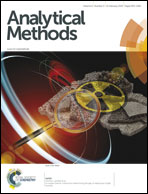Quantitative structure–retention relationships of ionic liquid cations in characterization of stationary phases for HPLC
Abstract
In this report chemometric methodology was utilized in comprehensive column comparative characterization in order to define patterns of similarity and dissimilarity between stationary phases under investigation. A quantitative structure–retention relationship approach was adopted to obtain statistically significant molecular-descriptor-based models describing the retention mechanism of eight ionic liquids in two home-made and five commercially available chromatographic columns. Consequently their retention mechanism was also studied and discussed. Principal component analysis was adopted to reduce the dimensionality of experimental data in order to characterize different stationary phases based on the behavior of ionic liquids. QSRR models together with stationary phase characterization provided reliable information on the properties and characteristics of the studied columns.


 Please wait while we load your content...
Please wait while we load your content...